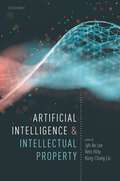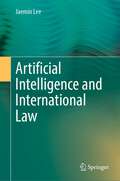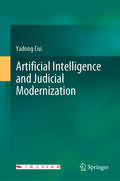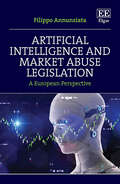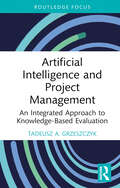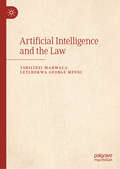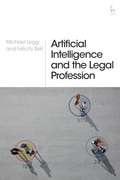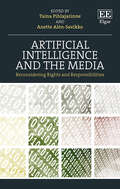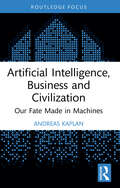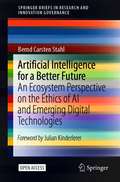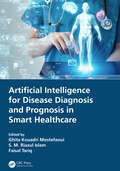- Table View
- List View
Artificial Intelligence and Intellectual Property
by Jyh-An Lee, Reto M Hilty, and Kung-Chung LiuArtificial Intelligence (AI) has become omnipresent in today's business environment: from chatbots to healthcare services to various ways of creating useful information. While AI has been increasingly used to optimize various creative and innovative processes, the integration of AI into products, services, and other operational procedures raises significant concerns across virtually all areas of intellectual property (IP) law. While AI has drawn extensive attention from IP experts globally, this is the first book providing a broad and comprehensive picture from the perspectives of the very nature of AI technology, its commercial implications, its interaction with different kinds of IP, IP administration, software and data, its social and economic impact on the innovation policy, and ultimately AI's eligibility as a legal entity.
Artificial Intelligence and Intellectual Property
Artificial Intelligence (AI) has become omnipresent in today's business environment: from chatbots to healthcare services to various ways of creating useful information. While AI has been increasingly used to optimize various creative and innovative processes, the integration of AI into products, services, and other operational procedures raises significant concerns across virtually all areas of intellectual property (IP) law. While AI has drawn extensive attention from IP experts globally, this is the first book providing a broad and comprehensive picture from the perspectives of the very nature of AI technology, its commercial implications, its interaction with different kinds of IP, IP administration, software and data, its social and economic impact on the innovation policy, and ultimately AI's eligibility as a legal entity.
Artificial Intelligence and International Law
by Jaemin LeeThis book examines the timely issue of artificial intelligence (AI) and law. At this moment, AI is rapidly developing and being utilized in many different sectors. Meanwhile, the rise of AI raises complex questions and poses new challenges—new products and services involving AI will require new regulations and standards to minimize potential negative side-effects and maximize the benefits of this new technology, both within domestic law and international law. Thus, this book focuses on the impact of AI on international law and seeks ways to develop international law frameworks to adequately address the challenges of the AI era. In this context, new forms of inter-state conflicts and emergence of new subjects and objects of international law are discussed along with relevant up-to-date developments in major jurisdictions. Issues arising from the advent of AI relating to state sovereignty, state responsibility, dispute settlements, and north-south divide are also considered.
Artificial Intelligence and Judicial Modernization
by Yadong CuiThis book comprehensively describes the status quo of artificial intelligence technology applications in the judicial field in China. Written by Cui Yadong, the former President of Shanghai Senior People's Court, it is divided into three parts: the first part focuses mainly on the theoretical issues related to artificial intelligence and judicial applications. The second part highlights practical aspects, discussing the research and development process, the implementation of the"206 system" and the major breakthroughs. The third part then addresses lessons learned and the thinking, particularly the thinking on "building the future rule of law of artificial intelligence", a new topic that responds to people's concerns about the risks and challenges of the development of artificial intelligence. In this context, the book argues that the judicial task is twofold: On the one hand, it should actively promote the integration and application of AI in the judiciary, judicial intelligence, and judicial modernization. On the other hand, it should encourage the construction of a future rule of law system of artificial intelligence, highlight the role of the judiciary in dealing with future risks and challenges, bring the development of artificial intelligence into line with the rule of law, and use the rule of law to promote, standardize and guarantee the safe, reliable and controllable development of artificial intelligence.
Artificial Intelligence and Machine Learning Powered Public Service Delivery in Estonia: Opportunities and Legal Challenges (Data Science, Machine Intelligence, and Law #2)
by Martin Ebers Paloma Krõõt TupayThis book gives a comprehensive overview of the state of Artificial Intelligence (AI), especially machine learning (ML) applications in public service delivery in Estonia, discussing the manifold ethical and legal issues that arise under both European and Estonian law. Final conclusions and recommendations set out and analyze various policy options for the public sector, taking into account recent developments at the European level – such as the AIA proposal – as well as the experience of countries that have issued principles and guidelines or even laws for the use of ML in the public sector. “For two reasons, this study is relevant not only for an audience which is interested in Estonian administrative law. First, the authors base their legal analysis primarily on EU law and provide a state of the art-analysis of the relevant secondary legislation. This makes the book a reference text for the European debate on public sector AI governance. Second, this study is part of a larger research project in which four specific use cases of public sector AI have been developed and tested. The practical insights gained in these projects have provided the authors with an excellent understanding of the opportunities and risks of the technology, which distinguishes this legal analysis from similar enterprises.” Excerpt from the foreword by Professor Thomas Wischmeyer (University of Bielefeld)
Artificial Intelligence and Market Abuse Legislation: A European Perspective
by Filippo AnnunziataArtificial Intelligence and Market Abuse Legislation presents a wide-reaching interdisciplinary examination of the impact of AI on the EU Market Abuse Regulation (MAR).Assessing the principles and rules governing the MAR disclosure regime as well as the mechanisms of market manipulation, Filippo Annunziata examines the important role of AI systems in the prompt disclosure of inside trading information. The author analyses the threat of breaches in disclosure protocol posed by technological malfunctions, as well as the opportunities and drawbacks presented by market manipulation in algorithmic trading. This incisive book goes on to argue for greater trading venue monitoring and the installation of adequate systems that can analyse, predict and thus anticipate situations that result in market manipulation.A state-of-the-art study analysing the impact of AI in relation to MAR from both a disclosure regime and an algorithmic trading perspective, this book will be critical reading for researchers interested in the law on AI, and in the regulation of global financial trading and market regulation. It will also be of interest to practitioners and policymakers working in the global financial sector.
Artificial Intelligence and Normative Challenges: International and Comparative Legal Perspectives (Law, Governance and Technology Series #59)
by Angelos Kornilakis Georgios Nouskalis Vassilis Pergantis Themistoklis TzimasArtificial intelligence (AI) – both in its current, comparatively limited form and even more so in its potential future forms (such as general and superintelligence) – has raised both concerns and hopes. Its actual and potential consequences are increasingly far-reaching, affecting almost every facet of human life on a collective and individual level: from the use of mobile phones and social media to autonomous weapons, and from the digitalization of knowledge and information to the patentability of AI innovations, unexpected philosophical, ontological, political and legal questions continue to arise.This book offers an insightful and essential guide to the scientific questions that are shaping humanity’s present and future. Presenting a collection of academic essays written by prominent scholars, it addresses the major legal issues concerning AI: its impact on a wide range of human behavior and the general legal response, including questions on AI and legal personhood; responsibility, liability and culpability in the age of AI; the challenges AI poses for intellectual property regimes; human rights challenges; and AI’s impact on jus ad bellum and jus in bello.Given its scope, the book will appeal to researchers, scholars and practitioners seeking a guide to this rapidly transforming landscape.
Artificial Intelligence and Patents: An International Perspective on Patenting AI-Related Inventions (AIPPI Series #8)
by Jonathan P. OshaArtificial Intelligence (‘AI’) and the AI sub-field of Machine Learning (‘ML’) are terms that originated in the fields of computer and data science but now form part of the common vernacular. AI has now found application in virtually every field. Some applications of AI have become part of our daily lives: virtual assistants, chatbots, search engines, online language translation and eCommerce all employ AI in various forms. Generative AI such as OpenAI’s products ChatGPT (natural language generation), Jukebox (music generation) and DALL-E2 (image generation) have captured the public attention to an enormous degree and can, indeed, do amazing things. A myriad of other applications of AI are found in disparate fields that, while not as visible on a daily basis, impact on our lives in a wide variety of ways. With this rapidly-increasing impact comes not only exciting new technical capabilities but also new challenges for intellectual property (‘IP’) law. Are current laws fit for purpose or is something new or different needed? This is not a new question; one need only look back to the early days of digital music, computer software and 3-D printing to find similar discussions of whether existing IP law is suited to emerging technologies. For the most part, the answer in the past has been “yes”, with perhaps a tweak here and there. Whether the same will be true of AI is, as yet, an open question. This book focuses specifically on AI and patents. Unsurprisingly, different jurisdictions have taken different approaches to patentability of AI-related inventions. Terminology (what is an “AI-related invention”?) also is inconsistent from one patent office to the next. These factors combine to create a maze of laws and regulations that patent applicants must navigate to secure protection for their innovations. To facilitate comparison of laws and practices, this book introduces a taxonomy that separates AI-related inventions into five conceptual categories. The patent law implications of each category are then addressed in national and regional chapters reflecting the perspectives of 16 major jurisdictions. All chapters follow the same structure, thereby allowing the reader to directly compare approaches taken by different jurisdictions. Thirty-nine subject matter experts from around the world contributed to this book. This is the eighth volume in the AIPPI Law Series which has been established together with the International Association for the Protection of Intellectual Property (AIPPI), a non-affiliated, non-profit organization dedicated to improving and promoting the protection of intellectual property at both national and international levels.
Artificial Intelligence and Project Management: An Integrated Approach to Knowledge-Based Evaluation (ISSN)
by Tadeusz A. GrzeszczykAlthough some people had doubts about the usefulness of such solutions in the past, artificial intelligence (AI) plays a growing role in modern business. It can be expected that the interest in it will also lead to an increase in support for the planning, evaluation, and implementation of projects. In particular, the proper functioning of multifaceted evaluation methods has a crucial impact on the appropriate planning and execution of various projects, as well as the effective achievement of the organization’s goals. This book offers a presentation of the complex problems and challenges related to the development of AI in project management, proposes an integrated approach to knowledge-based evaluation, and indicates the possibilities of improving professional practical knowledge in this field.The unique contribution of this book is to draw attention to the possibilities resulting from conducting transdisciplinary research and drawing on the rich achievements in the field of research development on knowledge-based systems that can be used to holistically support the processes of planning, evaluation, and project management. The concept of the integrated approach to knowledge-based evaluation is presented and developed as a result of drawing inspiration mainly from the systems approach, generative AI, and selected mathematical models.Presented in a highly accessible manner, the book discusses mathematical tools in a simple way, which enables understanding of the content by readers across broad subject areas who may be not only participants in specialist training and university students but also practitioners, consultants, or evaluators. This book will be a valuable resource for academics and upper-level students, in particular, across project management-related fields, and of great interest to all those looking to understand the challenges and effectiveness of AI in business.
Artificial Intelligence and Project Management: An Integrated Approach to Knowledge-Based Evaluation (ISSN)
by Tadeusz A. GrzeszczykAlthough some people had doubts about the usefulness of such solutions in the past, artificial intelligence (AI) plays a growing role in modern business. It can be expected that the interest in it will also lead to an increase in support for the planning, evaluation, and implementation of projects. In particular, the proper functioning of multifaceted evaluation methods has a crucial impact on the appropriate planning and execution of various projects, as well as the effective achievement of the organization’s goals. This book offers a presentation of the complex problems and challenges related to the development of AI in project management, proposes an integrated approach to knowledge-based evaluation, and indicates the possibilities of improving professional practical knowledge in this field.The unique contribution of this book is to draw attention to the possibilities resulting from conducting transdisciplinary research and drawing on the rich achievements in the field of research development on knowledge-based systems that can be used to holistically support the processes of planning, evaluation, and project management. The concept of the integrated approach to knowledge-based evaluation is presented and developed as a result of drawing inspiration mainly from the systems approach, generative AI, and selected mathematical models.Presented in a highly accessible manner, the book discusses mathematical tools in a simple way, which enables understanding of the content by readers across broad subject areas who may be not only participants in specialist training and university students but also practitioners, consultants, or evaluators. This book will be a valuable resource for academics and upper-level students, in particular, across project management-related fields, and of great interest to all those looking to understand the challenges and effectiveness of AI in business.
Artificial Intelligence and Security: 5th International Conference, ICAIS 2019, New York, NY, USA, July 26-28, 2019, Proceedings, Part I (Lecture Notes in Computer Science #11632)
by Xingming Sun Zhaoqing Pan Elisa BertinoThe 4-volume set LNCS 11632 until LNCS 11635 constitutes the refereed proceedings of the 5th International Conference on Artificial Intelligence and Security, ICAIS 2019, which was held in New York, USA, in July 2019. The conference was formerly called “International Conference on Cloud Computing and Security” with the acronym ICCCS.The total of 230 full papers presented in this 4-volume proceedings was carefully reviewed and selected from 1529 submissions. The papers were organized in topical sections as follows: Part I: cloud computing; Part II: artificial intelligence; big data; and cloud computing and security; Part III: cloud computing and security; information hiding; IoT security; multimedia forensics; and encryption and cybersecurity; Part IV: encryption and cybersecurity.
Artificial Intelligence and Security: 5th International Conference, ICAIS 2019, New York, NY, USA, July 26–28, 2019, Proceedings, Part IV (Lecture Notes in Computer Science #11635)
by Xingming Sun Zhaoqing Pan Elisa BertinoThe 4-volume set LNCS 11632 until LNCS 11635 constitutes the refereed proceedings of the 5th International Conference on Artificial Intelligence and Security, ICAIS 2019, which was held in New York, USA, in July 2019. The conference was formerly called “International Conference on Cloud Computing and Security” with the acronym ICCCS.The total of 230 full papers presented in this 4-volume proceedings was carefully reviewed and selected from 1529 submissions. The papers were organized in topical sections as follows: Part I: cloud computing; Part II: artificial intelligence; big data; and cloud computing and security; Part III: cloud computing and security; information hiding; IoT security; multimedia forensics; and encryption and cybersecurity; Part IV: encryption and cybersecurity.
Artificial Intelligence and the Law
by Tshilidzi Marwala Letlhokwa George MpediThis textbook offers a starting point for the education of attorneys and other legal professionals about the potential impact of artificial intelligence (AI) on the law, as well as a forum for discussing artificial intelligence's legal and ethical concerns. Intended for classroom use, this book will help students, legal professionals and policymakers alike. AI is swiftly transforming the world, including the legal system. Legal applications to areas such as ethics, human rights, climate change, labor law, health, social protection, inequality, lethal autonomous weapons, the criminal justice system and autonomous vehicles, contract drafting, legal investigation, criminal analysis and evidence investigation, utilize AI. As AI becomes more sophisticated, its impact on the law will likely increase.
Artificial Intelligence and the Legal Profession
by Michael Legg Felicity BellHow are new technologies changing the practice of law?With examples and explanations drawn from the UK, US, Canada, Australia and other common law countries, as well as from China and Europe, this book considers the opportunities and implications for lawyers as artificial intelligence systems become commonplace in legal service delivery. It examines what lawyers do in the practice of law and where AI will impact this work. It also explains the important continuing role of the lawyer in an AI world.This book is divided into three parts:Part A provides an accessible explanation of AI, including diagrams, and contrasts this with the role and work of lawyers.Part B focuses on six different aspects of legal work (litigation, transactional, dispute resolution, regulation and compliance, criminal law and legal advice and strategy) where AI is making a considerable impact and looks at how this is occurring.Part C discusses how lawyers and law firms can best utilise the promise of AI, while also acknowledging its limitations. It also discusses ethical and regulatory issues, including the lawyer's role in upholding the rule of law.
Artificial Intelligence and the Legal Profession
by Michael Legg Felicity BellHow are new technologies changing the practice of law?With examples and explanations drawn from the UK, US, Canada, Australia and other common law countries, as well as from China and Europe, this book considers the opportunities and implications for lawyers as artificial intelligence systems become commonplace in legal service delivery. It examines what lawyers do in the practice of law and where AI will impact this work. It also explains the important continuing role of the lawyer in an AI world.This book is divided into three parts:Part A provides an accessible explanation of AI, including diagrams, and contrasts this with the role and work of lawyers.Part B focuses on six different aspects of legal work (litigation, transactional, dispute resolution, regulation and compliance, criminal law and legal advice and strategy) where AI is making a considerable impact and looks at how this is occurring.Part C discusses how lawyers and law firms can best utilise the promise of AI, while also acknowledging its limitations. It also discusses ethical and regulatory issues, including the lawyer's role in upholding the rule of law.
Artificial Intelligence and the Media: Reconsidering Rights and Responsibilities
This timely book presents a detailed analysis of the role of law and regulation in the utilisation of Artificial Intelligence (AI) in the media sector. As well as contributing to the wider discussion on law and AI, the book also digs deeper by exploring pressing issues at the intersections of AI, media, and the law. Chapters critically re-examine various rights and responsibilities from the perspectives of incentives for accountable utilisation of AI in the industry.Featuring chapters from leading scholars in the field, Artificial Intelligence and the Media provides a timely and in-depth research-based contribution to complex themes - especially at the interface of new technology (including AI) with media and regulation. Analysing both legislative and ethical solutions, chapters explore what “AI” and “accountability” mean in terms of media practices, principles, and power relations, as well as how to address the AI revolution with informed law and policy in order to incentivise accountable utilisation of AI and to reduce negative societal impacts.Offering ideas for further research in the area, this book is key reading for academics and researchers in the fields of information and media law, regulation, and technology law. It may also interest media law practitioners, with research-based guidance for everyday practices and tools to prepare for future developments in the area.
Artificial Intelligence and the New World Order: New weapons, New Wars and a New Balance of Power (Frontiers of Artificial Intelligence, Ethics and Multidisciplinary Applications)
by Fatima RoumateThis book discusses the implications of artificial intelligence (AI) on post-COVID-19 international relations. With the decline and fall of U.S. global leadership and the emergence of new powerful actors, as hastened by the global pandemic, new arms are now used in new forms of wars with new players. The balance of power swings between geostrategic interests and those linked to the global governance of virtual space and the race to technological sovereignty. Chapters focus on the challenges imposed by these changes on different parts of the international system—law, governance, diplomacy, international psychological security—and articulate new strategies and ethical policies as possible solutions. The volume is interdisciplinary and will appeal to researchers, students, and professionals across fields interested in the ethics of AI in the international system.
Artificial Intelligence as a Disruptive Technology: Economic Transformation and Government Regulation
by Rosario GirasaArtificial intelligence (AI) is the latest technological evolution which is transforming the global economy and is a major part of the “Fourth Industrial Revolution.” This book covers the meaning, types, subfields and applications of AI, including U.S. governmental policies and regulations, ethical and privacy issues, particularly as they pertain and affect facial recognition programs and the Internet-of Things (IoT). There is a lengthy analysis of bias, AI’s effect on the current and future job market, and how AI precipitated fake news. In addition, the text covers basics of intellectual property rights and how AI will transform their protection. The author then moves on to explore international initiatives from the European Union, China’s New Generation Development Plan, other regional areas, and international conventions. The book concludes with a discussion of super intelligence and the question and applicability of consciousness in machines. The interdisciplinary scope of the text will appeal to any scholars, students and general readers interested in the effects of AI on our society, particularly in the fields of STS, economics, law and politics.
Artificial Intelligence, Business and Civilization: Our Fate Made in Machines (Routledge Focus on Business and Management)
by Andreas KaplanArtificial intelligence is shaking up economies around the world as well as society at large and is predicted to be either the best or worst thing to happen to humanity. This book looks at what exactly artificial intelligence is, how it can be classified, how it differentiates from other concepts such as machine learning, big data, blockchain, or the Internet-of-Things, and how it has evolved and might evolve over time. Providing a clear and unbiased picture of artificial intelligence, the book provides critical analyses of the advantages and disadvantages, opportunities and threats of AI progress for business and civilisation. Solutions and possible directions of how humanity might deal with rapid development and evolutions will be given and discussed, and consider regulation, employment, ethics, education and international cooperation. Unlike existing literature, this book provides a comprehensive overview of AI based on detailed analysis and insight. Finally, several real-life examples from various sectors and industries, including for profit organizations, higher education, and government, will substantiate and illustrate the presented concepts, classifications, and discussions. This book is of interest to researchers, educators, students, and practitioners alike who desire to understand AI in its broad lines and discover the latest research and studies within the field.
Artificial Intelligence, Business and Civilization: Our Fate Made in Machines (Routledge Focus on Business and Management)
by Andreas KaplanArtificial intelligence is shaking up economies around the world as well as society at large and is predicted to be either the best or worst thing to happen to humanity. This book looks at what exactly artificial intelligence is, how it can be classified, how it differentiates from other concepts such as machine learning, big data, blockchain, or the Internet-of-Things, and how it has evolved and might evolve over time. Providing a clear and unbiased picture of artificial intelligence, the book provides critical analyses of the advantages and disadvantages, opportunities and threats of AI progress for business and civilisation. Solutions and possible directions of how humanity might deal with rapid development and evolutions will be given and discussed, and consider regulation, employment, ethics, education and international cooperation. Unlike existing literature, this book provides a comprehensive overview of AI based on detailed analysis and insight. Finally, several real-life examples from various sectors and industries, including for profit organizations, higher education, and government, will substantiate and illustrate the presented concepts, classifications, and discussions. This book is of interest to researchers, educators, students, and practitioners alike who desire to understand AI in its broad lines and discover the latest research and studies within the field.
Artificial Intelligence, Computational Modelling and Criminal Proceedings: A Framework for A European Legal Discussion (Legal Studies in International, European and Comparative Criminal Law #4)
by Serena QuattrocoloThis book discusses issues relating to the application of AI and computational modelling in criminal proceedings from a European perspective. Part one provides a definition of the topics. Rather than focusing on policing or prevention of crime – largely tackled by recent literature – it explores ways in which AI can affect the investigation and adjudication of crime. There are two main areas of application: the first is evidence gathering, which is addressed in Part two. This section examines how traditional evidentiary law is affected by both new ways of investigation – based on automated processes (often using machine learning) – and new kinds of evidence, automatically generated by AI instruments. Drawing on the comprehensive case law of the European Court of Human Rights, it also presents reflections on the reliability and, ultimately, the admissibility of such evidence. Part three investigates the second application area: judicial decision-making, providing an unbiased review of the meaning, benefits, and possible long-term effects of ‘predictive justice’ in the criminal field. It highlights the prediction of both violent behaviour, or recidivism, and future court decisions, based on precedents. Touching on the foundations of common law and civil law traditions, the book offers insights into the usefulness of ‘prediction’ in criminal proceedings.
Artificial Intelligence, Design Law and Fashion (Routledge Research in Fashion Law)
by Hasan Kadir YılmaztekinArtificial intelligence (AI) now infiltrates our culture. After a couple of difficult winters, AI today is a word on everybody’s lips, and it attracts everyone’s attention regardless of whether they are experts or not. From Apple’s Siri to Amazon’s Alexa, Tesla’s auto-driving cars to facial recognition systems in CCTV cameras, Netflix’s film offering services to Google’s search engine, we live in a world of AI goods. The advent of AI-powered technologies increasingly affects people’s lives across the globe. As a tool for productivity and cost-efficiency, AI also shapes our economy and welfare. AI-generated designs and works are becoming more popular. Today, AI technologies can generate several intellectual creations. Fashion is one of the industries that AI can profoundly impact. AI tools and devices are currently being used in the fashion industry to create fashion models, fabric and jewellery designs, and clothing. When we talk about AI-generated designs, we instead focus on the fruits of innovation – more best-selling apparels, more fashionable designs and more fulfilment of customer expectations – without paying heed to who the designer is. Designers invest a lot of talent, time and finances into designing and creating each article of clothing and accessory before they release their work to the public. Pattern drafting is the first and most important step in dressmaking. Designers typically start with a general sketch on paper; add styles, elements and colours; revise and refine everything; and finally deliver their design to dressmakers. AI accelerates this time-consuming and labour-intensive process. Yet the full legal consequences of AI in fashion industry are often forgotten. An AI device’s ability to generate fashion designs raises the question of who will own intellectual property rights over the fashion designs. Will it be the fashion designer who hires or contracts with the AI programmer? Will it be the programmer? Will it be the AI itself? Or will it be a joint work of humans and computers? And who will be liable for infringement deriving from use of third-party material in AI-generated fashion designs? This book explores answers to these questions within the framework of EU design and copyright laws. It also crafts a solution proposal based on a three-step test and model norms, which could be used to unleash the authors, rights holders and infringers around AI-generated fashion designs.
Artificial Intelligence, Design Law and Fashion (Routledge Research in Fashion Law)
by Hasan Kadir YılmaztekinArtificial intelligence (AI) now infiltrates our culture. After a couple of difficult winters, AI today is a word on everybody’s lips, and it attracts everyone’s attention regardless of whether they are experts or not. From Apple’s Siri to Amazon’s Alexa, Tesla’s auto-driving cars to facial recognition systems in CCTV cameras, Netflix’s film offering services to Google’s search engine, we live in a world of AI goods. The advent of AI-powered technologies increasingly affects people’s lives across the globe. As a tool for productivity and cost-efficiency, AI also shapes our economy and welfare. AI-generated designs and works are becoming more popular. Today, AI technologies can generate several intellectual creations. Fashion is one of the industries that AI can profoundly impact. AI tools and devices are currently being used in the fashion industry to create fashion models, fabric and jewellery designs, and clothing. When we talk about AI-generated designs, we instead focus on the fruits of innovation – more best-selling apparels, more fashionable designs and more fulfilment of customer expectations – without paying heed to who the designer is. Designers invest a lot of talent, time and finances into designing and creating each article of clothing and accessory before they release their work to the public. Pattern drafting is the first and most important step in dressmaking. Designers typically start with a general sketch on paper; add styles, elements and colours; revise and refine everything; and finally deliver their design to dressmakers. AI accelerates this time-consuming and labour-intensive process. Yet the full legal consequences of AI in fashion industry are often forgotten. An AI device’s ability to generate fashion designs raises the question of who will own intellectual property rights over the fashion designs. Will it be the fashion designer who hires or contracts with the AI programmer? Will it be the programmer? Will it be the AI itself? Or will it be a joint work of humans and computers? And who will be liable for infringement deriving from use of third-party material in AI-generated fashion designs? This book explores answers to these questions within the framework of EU design and copyright laws. It also crafts a solution proposal based on a three-step test and model norms, which could be used to unleash the authors, rights holders and infringers around AI-generated fashion designs.
Artificial Intelligence for a Better Future: An Ecosystem Perspective on the Ethics of AI and Emerging Digital Technologies (SpringerBriefs in Research and Innovation Governance)
by Bernd Carsten StahlThis open access book proposes a novel approach to Artificial Intelligence (AI) ethics. AI offers many advantages: better and faster medical diagnoses, improved business processes and efficiency, and the automation of boring work. But undesirable and ethically problematic consequences are possible too: biases and discrimination, breaches of privacy and security, and societal distortions such as unemployment, economic exploitation and weakened democratic processes. There is even a prospect, ultimately, of super-intelligent machines replacing humans. The key question, then, is: how can we benefit from AI while addressing its ethical problems?This book presents an innovative answer to the question by presenting a different perspective on AI and its ethical consequences. Instead of looking at individual AI techniques, applications or ethical issues, we can understand AI as a system of ecosystems, consisting of numerous interdependent technologies, applications and stakeholders. Developing this idea, the book explores how AI ecosystems can be shaped to foster human flourishing. Drawing on rich empirical insights and detailed conceptual analysis, it suggests practical measures to ensure that AI is used to make the world a better place.
Artificial Intelligence for Disease Diagnosis and Prognosis in Smart Healthcare
by Ghita Kouadri Mostefaoui Islam, S. M. Riazul Faisal TariqArtificial Intelligence (AI) in general and machine learning (ML) and deep learning (DL) in particular and related digital technologies are a couple of fledging paradigms that next-generation healthcare services are sprinting towards. These digital technologies can transform various aspects of healthcare, leveraging advances in computing and communication power. With a new spectrum of business opportunities, AI-powered healthcare services will improve the lives of patients, their families, and societies. However, the application of AI in the healthcare field requires special attention given the direct implication with human life and well-being. Rapid progress in AI leads to the possibility of exploiting healthcare data for designing practical tools for automated diagnosis of chronic diseases such as dementia and diabetes. This book highlights the current research trends in applying AI models in various disease diagnoses and prognoses to provide enhanced healthcare solutions. The primary audience of the book are postgraduate students and researchers in the broad domain of healthcare technologies. Features In-depth coverage of the role of AI in smart healthcare Research guidelines for AI and data science researchers/practitioners interested in the healthcare sector Comprehensive coverage on security and privacy issues for AI in smart healthcare
